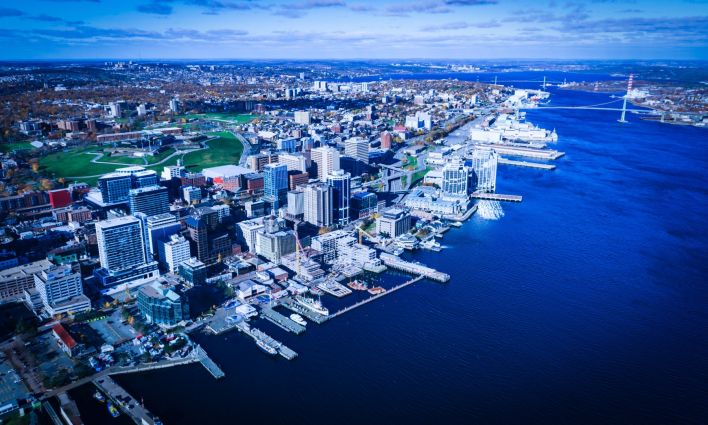On Tuesday, April 29 at Halifax City Hall, the Mayor and Council will (perhaps for the last time) hear from the public and debate the merits of supporting the construction of the proposed new downtown Halifax convention centre. Before the governments of Canada, Nova Scotia, and HRM give at least $400 million in public money over 25 years to a private developer to construct and operate the proposed convention centre, it is critical to bust some of the myths being used to justify this project. Given other needs that exist is this really justifiable?
The health of our democracy is fundamentally about transparency and accountability. How does this project stand up to those tests? On what basis is this decision being made and who will be held to account for it?
Myth 1: The convention centre is needed to spark downtown development.
Reality: Development is happening.
More than 136 new developments in the downtown that complied with view-plane regulations prior to the introduction of HRMbyDesign (a full list is available upon request).This includes 74 new developments, 52 expansion/conservation developments and approximately 10 approved but not yet constructed developments.
Myth 2: Resistance to the convention centre is emblematic of too much citizen opposition to downtown development.
Reality: Nova Scotia is not known for its planning decision appeals.
In a 2007 report, "What's Appealing, A Brief Comparison of Planning Appeals Across Canada" presented to the Atlantic Planners Institute by John Heseltine states that Nova Scotia, New Brunswick, and Newfoundland and Labrador have the most strict limits on who can appeal a planning decision (the appellant must be "aggrieved"); and that Nova Scotia had the least number of appeals per capita compared to other jurisdictions in Canada with just 12 annually -one appeal for every 79,000 residents and with roughly twice as many filed in rural areas than urban.
Myth 3: The convention centre is needed to fill a demand for new downtown office space.
Reality: Vacancy rates for downtown office space is increasing.
Recent market studies have determined there is surplus vacancy and high rental rates. One report shows that the downtown commercial vacancy rate increase to 9.9 % from 9.1%. Another report projects that when new developments such as Westhill on Duke St., Waterside Centre, TD Centre & Barrington Espace open, the vacancy rate is projected to climb to 10.6% by the fourth quarter of 2015.
Myth 4: A new convention centre will bolster the downtown economy through an infusion of public money into a project that is a promised game changer.
Reality: Worse-case scenario, the Convention Centre would lose at least $250 million over 25 years. Best-case scenarios have been questioned for their lack of independent analysis.
In 2010, CCPA-NS released an analysis of the data and concluded that the costs will outweigh the benefits no matter how you look at it. Indeed, the existing World Trade and Convention Centre Ltd (WTCL), built in 1985, did not hold up to the promised economic boosterism and it did not act as a specific catalyst to revitalize the downtown. For 2013/14, the WTCL forecasts a $2.76 million annual loss and reports that revenues were down 8.5%. The $2.76 million annual loss equals a $253 subsidy each year to every person attending a WTCL convention.
In November 2012, the Nova Scotia Auditor General identified similar problems, challenged the proposed new convention centre's 10-year market analysis for the business case and recommended an independent review before such a large amount of public money be spent. The auditor general flagged the over-supply of convention centres in Canada as not being a consideration in this business plan. So far, no independent analysis has been done.
Myth 5: There is broad public support for the convention centre.
Reality: A vast majority of Nova Scotians questions the benefits and return on investment of this project especially given other priorities across the province.
A new provincial poll by Abacus determined that 86% of Nova Scotians want an independent review of the project before spending money on the project. The poll also revealed that 89% of Nova Scotians felt that the $51 million federal grant earmarked for the new convention centre would be better spent on roads, bridges, and public transportation throughout the province than on a new convention centre. In addition, 59% of respondents were opposed to the Halifax Regional Municipality changing the bylaws in order for the convention centre to be built.
Myth 6: The redesign of the convention centre gets the tax-payer a better deal.
Reality: The new design further calls into question the public value of this project.
The proposed Halifax convention centre developer, Rank Inc., has a new building proposal, which is to be considered by regional council at a public meeting 6pm, Tuesday, April 29th at HRM City Hall to ask for the citizens' permission to allow the developer to break HRMbyDesign planning regulations in twenty ways. The towers on top of the convention centre would be twice as big as the original proposal, but the new convention centre itself will have a smaller ballroom and a smaller exhibition space than the original proposal and than specified in the RFP. As well, the public will be asked to allow the developer to privatize and own a block of Grafton Street, described as turning it into “a private driveway into the complex from Prince Street”.
Where we could spend $400 million instead?
With so many other better ways to spend public money for public benefit isn't it time to reprioritize the public money, which is planned to be spent to subsidize the convention centre?
The Alternative Provincial Budget for Nova Scotia suggests many ways that this money could be spent. For example the annual spending expenditures of $7.1 million from the province to the proposed new convention centre would cover the cost of a nutrition and food skill education program in schools for P-12 ($2.4 million); establish a drug treatment court in Halifax; support a community-based crime prevention initiative ($2 million); and increase the budget to support labour market training initiatives for African-Nova Scotian and Aboriginal people ($1 million).
The federal contribution of $51.4 million was intended for infrastructure development for benefit to all Nova Scotians. It could be reprioritized to build affordable non-profit housing ($30 million) or establish a universal service program for energy use in low income households ($33 million); establish Transit NS for bus service throughout the province ($18 million) or/and build co-op housing for artists and students or address rural infrastructure deficiencies including water and waste water infrastructure. For more ideas see the Alternative Federal Budget.
We haven't yet considered what we could do with the HRM contribution of $7.1 million per year. More public library funding? Additional Community Recreation Programs? There is a long list of ideas to be found in the Alternative Municipal Budget for HRM.
As for the question of whether this project passes any democratic tests, Christopher Majka best sums this up: “as a public policy initiative it [the convention centre] has been a concatenation of confusion, delusion, fabrication, omission, deception, missed opportunities, sleight's of hand, and willful blindness. It's not a template for development that anyone ought to aspire to.”
Peggy Cameron is a Research Associate of the CCPA-Nova Scotia. She can be contacted at p.cameron@ns.sympatico.ca





